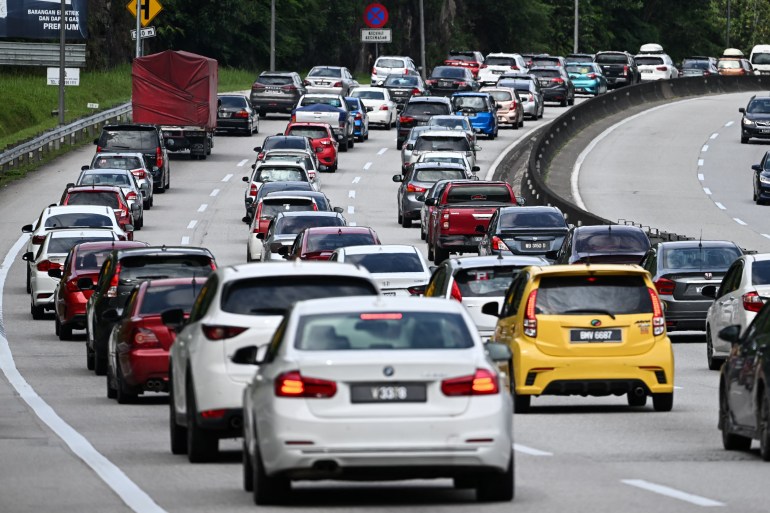This 12 months noticed a rise in pure disasters the world over, from floods in Libya and New York and lethal wildfires in Hawaii and Greece – all very actual results of local weather change.
Globally, there have been twice as many days the place temperatures exceed 50 levels Celsius (122 levels Fahrenheit) than 30 years in the past, with this 12 months being declared the most popular on file.
Malaysia is only one nation that has been going through its personal set of local weather points. In current years it’s confronted an unprecedented rise in temperatures inflicting warmth islands to devastating floods, like those in 2021, displacing hundreds as houses submerged underneath water.
Although the Southeast Asian state was as soon as criticised for its contribution to international warming, attributable to deforestation on land used for palm oil cultivation and extra lately for its use of coal-fuelled energy stations – it’s additionally been on the forefront of local weather mitigation.
But its new minister for pure assets and environmental sustainability, Nik Nazmi, has mentioned extra must be completed. Since taking the helm of his nation’s local weather change measures final 12 months, he’s already mentioned no extra new palm oil plantations and coal crops.
Instead, he desires to extend electrical energy tariffs for the rich hoping to direct them in direction of different vitality, whereas persevering with to subsidise electrical energy and gas for the much less well-off.
Ultimately, steering his nation in direction of a extra sustainable way of life, he says, can’t be achieved by means of governmental insurance policies alone, however by means of altering mindsets and returning to shared human values.
Here’s extra from Al Jazeera’s dialog with Nik Nazmi, Malaysia’s minister for pure assets and environmental sustainability:
Al Jazeera: Can you inform us extra about Malaysia’s local weather adaptation plan and when it’s anticipated to come back into motion?
Nik Nazmi: Our goal is for the National Adaptation Plan and the Climate Change Act to be prepared by 2025.
It’s a multifaceted strategy that may take care of creating infrastructure.
In current years we’ve confronted flooding, so we are attempting to maneuver away from impermeable surfaces like concrete and tarmac and in direction of different breathable supplies. We additionally need to construct extra houses and providers additional inland – as a result of Malaysia is a mountainous nation total, individuals are usually pushed to stay close to the coast or the river basins, however that additionally means lots of people are then uncovered if there’s a significant sea degree rise.
In the previous few years, the extent of warmth has been a lot greater than ordinary. We seen temperatures may be decrease in inexperienced areas in comparison with built-up areas – by as a lot as 6C (42.8F). We are planning our cities utilizing a nature-based strategy, by planting extra greenery and parks. We are attempting to slowly transfer and alter in order that finally we are able to overcome the city warmth island impact.
Al Jazeera: Would you say Malaysia’s manufacturing of palm oil – the nation’s prime crop for 3 many years – is contributing to this rise in international temperatures, as a number one contributor to deforestation and greenhouse fuel (GHG) emissions?
Nazmi: It might have been at one time, however that isn’t the case now.
In Malaysia, most of our plantations, [98 percent] are lined, even the smallholders are lined, underneath the Sustainable Palm Oil initiative. It’s a transfer that has been recognised, even by worldwide research, in considerably lowering deforestation from palm oil.
Yes, we’ve got a really widespread sustainable palm oil trade, however there’s a restrict to the scale of our palm oil plantations. Both the timber trade and the palm oil trade in Malaysia are very a lot regulated.
There aren’t any new plantations deliberate.

Al Jazeera: But hasn’t the State of Kelantan been giving out concessions encouraging extra palm oil manufacturing? Is the federal authorities making an attempt to cease it?
Nazmi: Under our Constitution, the state authority is in command of land and forests, and the federal authorities regulates and coordinates it.
If there was a problem in Kelantan the place the environmentally delicate areas have been deconstructed, and this consists of areas of everlasting forest reserves that are going to be given to a palm plantation, then they won’t get the Malaysian Sustainable Palm Oil certification.
Our Sustainable Palm Oil initiative has been a significant factor in defending the forest, and it’s one thing we don’t get sufficient recognition for.
The Sustainable Palm Oil initiative has made an enormous distinction, however so has our Sustainable Forest Management Programme. This appears to be like at methods to guard the forest and permit it to redevelop, to regrow.
We are a federation with land and forests all underneath state management. We give state governments a sure amount of cash for them to order their forests. The quantity is predicated on how massive the scale of the forest that they proceed to keep up is, whether or not they proceed so as to add to forest reserves, or whether or not they do some other initiatives to enhance that.
We used to pay 70 million ringgit a 12 months [$15m], however final 12 months – 2022-2023 – we managed to extend it to 150 million ringgit [$32m]. And for 2024, the Prime Minister has already introduced within the price range 200 million ringgit [$42.9m]. So that’s an enormous quantity.
Is it sufficient? It’s not sufficient, but it surely’s a superb begin. We’ve additionally had a nationwide Forestry Act, which was handed in 2022. This implies that for state governments, they should do public inquiries earlier than they’ll work on any forests. They additionally should immediately change these forests, by replanting.
Those are all of the issues that we tried to do so as to ensure that we shield our best asset – the forest.
Al Jazeera: What concerning the wildlife throughout the forests? Al Jazeera has lined the close to extinction of the Malayan Tiger earlier than – there at the moment are thought to now be lower than 100.
[Kindly recheck Q above, the nows toward the end]
Nazmi: We have a number of measures in place right here.
First, it’s about coping with the fragmentation of habitats, the lack of wildlife corridors, proper? If you construct a street by means of a forest, or in the event you construct a plantation in that, then it is going to have an effect on the wildlife. You should preserve a good dimension of forest cowl, however in the event you cut up it up, then you recognize, animals like elephants and tigers, they want an enormous vary to journey. So we are attempting to maintain the forest intact as a lot as doable.
Yes, there are nonetheless some roads and rail, but it surely’s restricted. Places the place it’s unimaginable for us to not have that infrastructure, we’re constructing wildlife crossings – secure areas for animals to cross roads and rail tracks – that’s within the works.

There’s additionally an ASEAN initiative known as the Heart of Borneo, which covers the Malaysian states of Sabah and Sarawak, but in addition Brunei and Kalimantan, Indonesia. So it’s principally the North East centre of Borneo that could be a protected nature reserve, the place you will have pygmy elephants and orangutans.
And lastly, we even have an internationally acclaimed programme of Community Rangers, the place we work with navy veterans and Indigenous tribes – as a result of they know tips on how to transfer within the jungle. They assist to place boots on the bottom to take care of poachers, unlawful mining and deforestation. They’ve been very efficient from our research, when it comes to serving to to guard our tigers and elephants and different wildlife.
Al Jazeera: Malaysia is the third-largest producer of photo voltaic panels globally, and regardless of falling prices of photo voltaic know-how, adoption charges in Malaysia stay low, why is that?
Nazmi: It’s as a result of our electrical energy is so low-cost, it’s one of many least expensive within the area. Although our salaries are most likely greater than many nations within the area, the tariffs are among the many lowest and the subsidies are very excessive.
In the previous, you recognize, the federal government needed to draw traders, and cheaper electrical energy helped that, and the individuals working for these firms, additionally had subsidised electrical energy. That gained’t encourage individuals to put in photo voltaic and different issues, as a result of it’s simply cheaper to get it from the grid.
But since I took over in December final 12 months, we’ve steadily elevated the tariffs for electrical energy for each the larger companies and in addition for factories – but in addition for richer households.
The concept is that the subsidies ought to be focused, extra for the poor, and possibly a few of the center class, however actually not the wealthy. They are the largest customers, utilizing air conditioners, garments dryers and swimming swimming pools. So it’s completely unfair.
We have shifted away from that, and we’ve seen the clamour for photo voltaic has elevated tremendously, even for companies now. It’s partly due to new laws with regard to sustainability, but in addition as a result of now the electrical energy payments are greater, they complain, clearly. But after some time, then they began doing vitality effectivity and putting in photo voltaic. I imply, that makes financial sense. So I feel we are going to see that to be rising tremendously over the subsequent few years.
Al Jazeera: Isn’t the electrical energy in Malaysia primarily generated by coal? Why is coal nonetheless getting used there when different nations have moved away from it? And is something being completed to scale back its use?
Nazmi: Recent knowledge exhibits that in 2021 we’ve handed the height of coal utilization.
At the purpose of independence [from the British in 1957], a variety of our vitality got here from diesel energy crops. And then once we had the rise in oil costs [in the 1970s], we began to make use of extra coal – bear in mind that is earlier than we had hydroelectricity. Coal continued to change into extra in style within the early 2000s, due to value points on the time.
But now, we’ve declared that there’ll be no extra new coal crops in Malaysia.
The problem – that we settle for – is the economics of all of it, as a result of, not like many Western nations, our coal crops in Asia are usually youthful. So once you need to speak about retirement, it’s way more costly than in different nations.
We know that it’s a unclean gas – and that’s why we’ve mentioned no new coal crops, and that’s why we’re taking a look at methods to scale back the carbon from coal.
It needs to be completed in a simply and correct manner in order that the burden isn’t then positioned on atypical Malaysian customers.
We are additionally in search of a request for data to get concepts on tips on how to scale back carbon emissions from coal from early retirement of coal crops, however that’s nonetheless difficult.
We’ve seen what Indonesia is making an attempt to do and Vietnam is engaged on it, in addition to the Philippines. We are taking a look at mothballing, it’s what Germany and China did. Or even co-firing, both with ammonia or biomass, so that you scale back emissions or transfer from brown to inexperienced – so moderately than coal, you can provide the identical firm a licence to make use of photo voltaic or different types of inexperienced vitality and slowly scale back.

Al Jazeera: Talking about atypical Malaysian customers, they’ve the very best charges of per capita personal car possession within the area: More than 40 p.c of Malaysia’s whole vitality consumption comes from transport – are there plans to show this round?
Nazmi: Public transport is in fact one of the best ways ahead. In KL [Kuala Lumpur], we’re including a second line for the MRT [Mass Rapid Transit], a significant connector for the varied rail traces within the metropolis, after which there’s the Light Rail Transit [LRT].
But on the identical time, we additionally recognise that we have to take a look at EVs [electric vehicles] as a result of individuals nonetheless want automobiles, and never everybody lives in areas with a developed public transportation system.
Al Jazeera: Is something being completed to vary mindsets? To get extra individuals keen to leap on a bus or a practice, as a substitute of taking their very own personal automobiles?
Nazmi: Yes in fact. Fuel right here is closely subsidised, however in the event you drive an enormous, luxurious automobile, like a Porsche, or BMW, you truly get extra subsidies than the man who rides a motorcycle, in order that’s problematic and that’s why we’re working in direction of gas subsidies to be focused, the place solely the poor, and possibly a few of the center courses may be given help.
So altering attitudes and habits. It’s not nearly going for an EV, as a result of the way in which you cost automobiles is completely different and desires the infrastructure, the charging stations.
It additionally requires a variety of political will, and the federal government is engaged on that. We are attempting to push each EV and public transport to go hand in hand slowly.
Al Jazeera: You had been at COP28 this 12 months and also you’ve mentioned the Loss and Damage Fund ought to do extra to scale back the burden on all growing nations – are you able to inform me extra?
Nazmi: The definition that’s at all times talked about, is it ought to be reserved for least developed nations and small island states, and undoubtedly they want it, I don’t query that.
But to restrict it to these nations alone… If you make it so small, then it makes it meaningless.
In Malaysia, we’ve got a big impact from local weather change. Yes, we’re center revenue, even maybe excessive center revenue. But, you also needs to take a look at the truth that Southeast Asia is a significant sufferer of local weather change – that makes it in the identical class as small island nations, proper?
Pakistan, Bangladesh, even Libya aren’t eligible. And in fact, they’ve been massively affected by floods and varied calamities – and I feel that’s an issue.
As for the cash that’s been promised, the pledge, it’s been talked about since 2009. The 2015 Paris Agreement, said $100bn a 12 months from the developed world, proper? We at the moment are nearing $1 trillion, that ought to be the case proper now, however we’ve got $80bn – so there’s an enormous pledge, however there’s at all times a scarcity of cash within the financial institution.
We aren’t simply talking on behalf of Malaysia, however we’re checked out as being one of many voices of the growing world, and we need to champion that.
Al Jazeera: You’ve additionally talked about the necessity for a world stocktake – why is that vital?
Nazmi: The international stocktake underneath the UNFCCC is vital for us to evaluate the collective progress of implementing local weather actions in order that we are able to obtain the goals underneath the Paris Agreement.
For us, the science is obvious, we are able to see local weather change taking place in entrance of our eyes. And clearly, many nations have introduced their targets, the pledges, so it’s vital to have the worldwide stocktake, to see the place we’re at.
So we don’t delude ourselves, and we are able to perceive the urgency of attaining our objectives, and to see what extra must be completed. Business as ordinary isn’t an possibility.
The subsequent step is the precept of fairness, you recognize, frequent however differentiated accountability, nations which have completed this, they haven’t solely torched their very own forests, however they’ve additionally razed our personal forests, for a whole bunch of years and change into wealthy out of it. It’s time a few of the developed world nations busy increasing their very own oil fields stopped lecturing and carried out local weather measures.
Al Jazeera: How do you make sure that all this work that you simply’re doing, at governmental degree, is carried out on the grassroots ranges as nicely?
Nazmi: There’s this good quote by this American environmental lawyer, Gus Speth, the place he talked about that he used to suppose that the issue, the planetary disaster that we’re experiencing, is on account of local weather change, biodiversity loss, but it surely’s truly a problem of selfishness and spirituality.
That’s the center of it, proper, and that’s what must be addressed on the grassroots degree. At the identical time, you will have the poor, who aren’t even getting fundamental vitality, fundamental water to outlive, and you’ve got the wealthy who’re dwelling past the restrict. So I feel working in direction of a “spiritual and cultural transformation”, as Speth urged, is what’s most wanted.
In a rustic like Malaysia, faith is vital throughout the board, whether or not you’re Muslim, Christian, Hindu, Buddhist – so discovering frequent values to take care of local weather change, will work in direction of dwelling in a extra sustainable world, it’s vital.
We’ve launched a number of consciousness campaigns addressing these values, utilizing language and concepts which might be universally understood – very fundamental values, like tips on how to be extra conscious and never being wasteful, these are ideas inspired by all faiths, proper.
https://www.aljazeera.com/news/2023/12/26/will-raising-fuel-and-power-bills-make-malaysians-go-solar?traffic_source=rss


